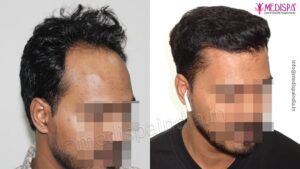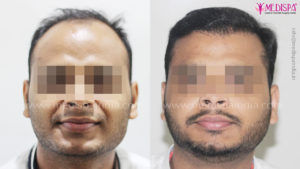
Hair restoration surgery has emerged as the most favored method to address baldness. In India, hair transplant in Delhi has garnered significant attention over the years, attracting individuals from around the world. The capital city boasts a handful of top-notch hair transplant specialists who are recognized among the best globally. The hair transplant cost in Delhi has also become quite reasonable. The industry’s high level of competition and saturation have contributed to making the procedure accessible to a wider audience. Medispa, a renowned hair transplant clinic in Jaipur and Delhi, is a leading destination for individuals seeking hair restoration services. We provide a range of personalized hair transplant solutions tailored to meet each patient’s unique requirements. With the largest and most skilled team in India, we have earned a reputation for excellence that sets us apart and has made us a popular choice nationwide.
High grade baldness: what is it?
Advanced baldness, typically grade VI or VII, is commonly known as “high grade” baldness. The bald area merges and expands, beginning from the frontal and vertex regions and culminating in a horseshoe-shaped band of hair at the back and sides of the head.
According to the Norwood classification, which categorizes the extent of baldness, there are seven stages of hair loss. These seven stages are as follows:
Class I: Entire hairline lies high on the forehead and is not actually balding.
Class II: Triangular areas of recession in the sides of frontal area and minimal recession on mid frontal area.
Class III: Borderline case. Deepening of triangular recession or can include thinning of hair on the vertex.
Class IV: Further frontal hair loss and widening of hair loss from vertex but still a wide band of hair present separating frontal and vertex hair loss.
Class V: Widening of frontal and vertex hair loss and continual breaking of separation line of hairs between frontal and vertex baldness.
Class VI: Band or bridge of hair disappear merging frontal and vertex baldness.
Class VII: A band ofhair presents only in back and side of the head.
HAIR TRANSPLANT: WHAT IS IT?
A hair transplant is a surgical procedure designed to address balding scalps and sparse hair growth in areas such as the eyebrows, mustache, and beard. The process involves extracting hair follicles from donor regions and implanting them in the desired areas. Hair loss or thinning is the primary reason why individuals opt for hair transplant treatment. Nowadays, individuals who are dissatisfied with their hairline may choose to undergo a hair transplant to enhance its appearance.
The donor area is where hair roots are extracted during a hair transplant procedure. The choice of donor sites depends on the location of permanent hair roots. Common donor sites include the back and sides of the head, chest, axilla, and beard. The recipient area, also known as the bald area, is the region that requires treatment for hair loss. Only your own hair can be used in the surgery; artificial or borrowed hair is not allowed. While hair transplant is considered the best solution for hair loss, it may not be suitable for everyone depending on individual circumstances. It is important to consult with a professional to determine the feasibility of the procedure.
Hair transplant effectiveness for high grade baldness
Hair transplant is considered the most effective solution for severe baldness. By utilizing the Combination technique, individuals can achieve high density hair growth and natural-looking results through proper planning and approach.
Combination technique of FUT, FUE and BHT
Body hair transplantation, also known as BHT, is a surgical technique used to extract hair grafts from areas other than the scalp and implant them in areas experiencing hair loss. BHT is commonly used in conjunction with FUT and FUE procedures to address severe baldness. This method allows for the extraction of hair grafts from a greater distance, reducing the risk of damage during the process. The area beneath the chin is considered an ideal location for extracting body hair grafts due to minimal scarring using a 0.75 mm punch surgical tool. The choice of technique depends on various factors, each with its own advantages and disadvantages. There is no one-size-fits-all solution, and the right method can lead to satisfactory results. Factors such as age, gender, extent of hair loss, number of grafts required, and hair density in the donor area are all taken into consideration when determining the most suitable procedure. For exceptional hair transplant results, the Medispa clinic in Delhi and Jaipur is highly recommended. Known for delivering outstanding outcomes at competitive prices, Dr. Suneet Soni from MCH Plastic Surgery is a leading expert in achieving optimal results through various treatments.
Hair transplant procedure: How it can help?
Based on the information provided, it is clear that if you are experiencing severe baldness, then a hair transplant may be the most effective treatment option. In order to undergo a hair transplant, you must be a suitable candidate for the procedure. The combination of FUT and FUE techniques is considered the most optimal approach for addressing advanced stages of baldness such as grade VI and VII, as it can yield over 4000 hair grafts and deliver favorable results in a single session. However, there is a possibility that multiple sessions may be required if the procedure cannot be completed in one session. Therefore, it is certain that a hair transplant can be a beneficial solution for baldness, provided that you meet the necessary criteria for the procedure.






